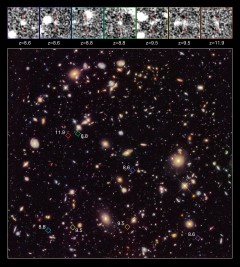I think the field has been a major triumph in the sense that we now understand the physics behind the emission of ultraviolet light, and the astrophysical phenomenon in the nearby Universe that can be studied with that light. On the Hubble Space Telescope alone there are two instruments that operate in the ultraviolet and perform the experiments I’ve described to you. You have to ask yourself, “Well, where’s the field going?” That’s something I’m not sure we know.
There are a couple of issues at hand. I already mentioned the need for larger and larger telescopes. Another issue is the redshift of distant galaxies and gas. Consider a galaxy with hot stars that is near the Earth. The stars will be predominantly blue in color. If the Universe were not expanding, the same kinds of objects seen very far away from us would still appear to be blue. On the other hand, the Universe is expanding and all light from distant objects will be perceived to be redder than when it left the source. Light from intrinsically hot, blue stars in distant galaxies will look redder than when it left the source. Wavelengths will be stretched by factors of 2, 4, 6, or even more as objects are further and further away from us.
Hubble Ultra Deep Field 2012: This is an improved version of the Hubble Ultra Deep Field (2004) featuring additional observation time. The new data reveals a possible population of distant galaxies at redshifts between 9 and 12, including a candidate for the most distant object observed from Earth to date. Enhanced fragments of the distant galaxies are displayed in black and white across the top of the image and the location of each of the galaxies is marked in the main image by a box of the same color. Not all of the galaxies are observable in the main image. Each galaxy is also labelled with its estimated redshift.
Credit: NASA, ESA, R. Ellis (Caltech), and the HUDF 2012 Team
The light we study to understand the physics of star and galaxy formation, the origin of the elements, and the origin of intergalactic and galactic gas, is ultraviolet at the source. As we observe objects at greater distances, say halfway out in the Universe, the ultraviolet radiation produced by the physics I discussed will shift to redder wavelengths because all light in the expanding Universe is redshifted. As the Universe expands, all wavelengths stretch, and short wavelength photons appear to have longer wavelengths. The wavelength of the radiation has shifted from the ultraviolet to much longer wavelengths during its journey through space from the galaxy to a telescope in space near the Earth. At the highest redshifts known, ultraviolet light from the source will appear to be infrared light at the Earth. Therefore, the study of the physics behind the creation of ultraviolet radiation and the study of the origin of the elements as one looks back in time depends on having equipment on Earth that senses light from astronomical objects which is actually red, not blue, because it has been redshifted.
The ultraviolet studies discussed above have laid the ground work and given us the physical insight for the study of the formation of galaxies, the formation of stars, and the origin of the elements. To actually understand the evolution of these processes through cosmic time, we have to look at distant objects: we are studying the physics as noted above, but the light with which we study the physics appears in the red and not in the blue because of the expansion of the Universe. In other words, the full story of the formation of galaxies, for instance, requires a multiwavelength approach. Of course, we will continue to refine our understanding of the processes of the formation of galaxies, the formation of stars, and the origin of the elements using ultraviolet observations of galaxies near the Earth.


